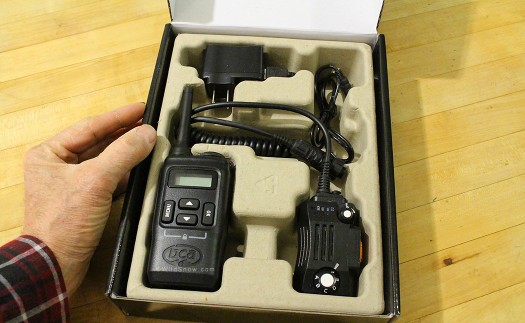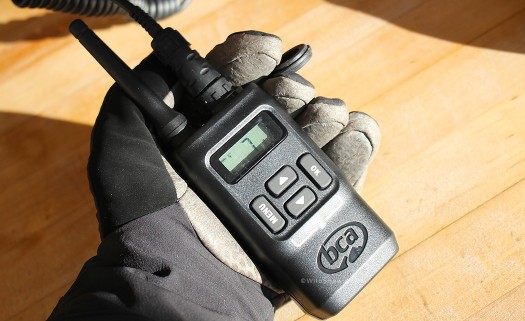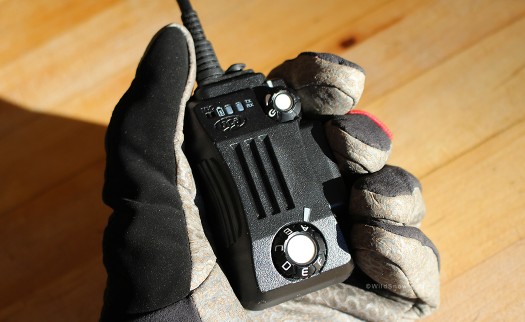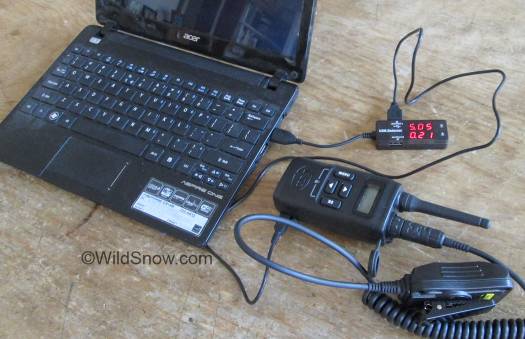Shop for BCA Link radio system.
BCA Link radios are cool. From the plain black-on-black styling to the waterproof connectors, Link from Backcountry Access reeks of quality and downright functionality. I got one of the first retail units in 2013 and it tested out quite nicely. I unboxed a 2015-16 unit this autumn of 2015 to see if it’s the same rig (it is), and for inspiration to update this review.
(In terms of “new” know that a European version of the Link is available, with EU public use channels/frequencies known as PMR446. Culturally speaking, I’ve noticed that the North American FRS frequencies get used in Europe simply because such radios have become ubiquitous worldwide. We’ll see how that shakes out in the coming years. Main thing to remember is if in Europe do NOT use your FRS radios if you’re in civilized areas as the same frequencies are apparently in use by some EMS outfits. If you’re out ski touring in the European semi-wild and using FRS with its default limited power and range, I doubt it’s a problem. If you ski with locals who use radios, you may need a different rig.)

Grand unboxing of BC link. The sound of heavenly radio transmissions came down from on high as we lifted the lid. I have a feeling a few of these will be opened Christmas morning.
The concept is bold. Instead of trying to match the bloviated “blister pack” FRS/GMRS radio market with a Gallactica toy lookalike, in 2013 BCA came up with an understated black moisture sealed radio designed specifically for snow sports such as ski touring. Idea is you carry the base unit in your backpack or perhaps a jacket pocket (also has a belt clip if you want to totally geek out). Controls for normal use are on the mic, while you set your background settings (channels, beeps-on-off, etc.) on the base unit.
I’m about as familiar with FRS/GMRS walkie-talkies as you can get (as well as licensed Amateur radio operator KC0FNM). Thus, only surprise here is that without a PTT (push to talk) switch on the base unit, I expected the Link radio to be smaller. But the base unit has to carry a fair sized lithium rechargeable battery, which probably drives the form factor.

Link's base unit is designed to run inside your backpack, with external handmic providing enough control for normal use.

Link handmic (otherwise known as a speaker mic/microphone) has necessary controls. Small dial at top right is on-off and volume. Lower dial with letters is the channel pre-sets. A series of LEDs at top left indicate the radio being powered up, transmitting, etc.
Speaking of the battery, per current pop electronics you can only charge the BCA Link via USB. This requires the usual USB wall-wart adapter if you want to juice from residential 110v or 220v wiring. The provided USB cable and connector on the radio is the mini-B plug basic USB (not the micro versions you normally use for a smartphone). With the mini-B connector on one end of a cable and the correct connector on the other, you can charge the radio from any device that has a USB power socket (computer, for example).
Mixed emotions about USB power. In an ideal world, USB would simplify things. But shucks, with a dozen or more different types of USB connectors out there (was this designed by Microsoft?), I still carry a spaghetti mess of cables and adapters during travel, so really, things are just as complicated as in the old days. What is more, I still feel the ideal DC voltage standardization for 2-way radios is the >< 12 volt DC power of automobiles, supplied via a barrel connector. But that's another story. Of more importance, you'd better have a good charging strategy for BC Link if you're on a multi-day backcountry skiing trip without electricity. I'll do the official WildSnow begging to BCA for an AA battery pack, but something tells me this won't be forthcoming any time soon. Instead, look to any of the aftermarket auxiliary USB charger bricks, such as those by Anker and Goal Zero. You might need one of those to charge your Smarphone-GPS as well? More about charging: My biggest gripe is that the radio unit lacks a charging/charged indicator that works when the handset is disconnected and you’re charging the base unit only, while using any generic USB cable connected to the radio via the USB mini-B plug. In this case, you have no way to know if the Link is charged or not unless you disconnect from the charger, attach handset, turn on the radio, and check battery level in the LCD. Moreover, even with the handset attached and the radio powered down, you get no visual feedback if you connect with a generic USB cable to, for example, a computer USB port.
These are very real concerns. Standard industrial design in electronics (thanks Mr. Jobs) is to provide robust user feedback re charging cycles. (E.g, smartphone) At the least, can’t the radio base unit have an indicator light showing it’s getting charging power? It’s silly I have to go on Amazon and buy an inline volt/amp meter I can hook up when I’m charging the Link just so I know if I’m using a defective cable or not.
But yes, aftermarket to the rescue: If you want a nice little gadget (useful for travel, to check your USB charging of nearly any device) see link to right. I received and tested the “USB Detector” as shown available from Amazon. It’s really quite a nifty little device. Leaves no doubt as to whether you’re got power in a given USB port on a computer or whatever (ideally should read something like 5 or 5.1 on the top “V” readout. The bottom readout is the amperage. With no device connected to the detector the amperage should read zero. Device charging will up the amperage, then when the charging cycle is done the amperage will go down to near zero, or in the case of BC Link, the Detector reads a fat zero once charging is done. Again, quite nice.

Volt-amp meter hooked up for charging BC Link from computer USB, with radio switched totally off. This yields good user feedback. The 5.x reading is the USB voltage, it should be at least 5 volts. The other reading is the current (amperage) being pulled by charging the radio. Once the charging is done, if the radio is turned off the current will read zero or near zero. Very nice. No guesswork and the meter can be used with most USB powered devices as far as I can tell.
(Warning about purchasing the USB Detector linked here. Apparently there are some poorly functioning counterfeits for sale on Amazon along with the real deal. The one we linked to appears to be the real thing and tests out fine so far. Read the Amazon consumer reviews before deciding on purchase, and beware of offers that save you a dollar or two. I’ve been doing quite a bit of shopping on Amazon lately and noticed they’re becoming quite a jungle. Buyer beware, as always.)
Battery Life
Enough whining and moaning on my part. Link’s battery life is terrific. I did one test that involved leaving the radio switched on for 4 days about 24 hours a day, with moderate use each day. Battery was still going strong at the end of that period. Charge every night (with some kind of setup that indicates you are actually charging, see above) and you never need worry about using the radio all day long. (Nonetheless, for battery life insurance still use good radio technique such as speaking clearly and concisely instead of rambling or fooling around, as well as turning the unit off when not in use.)
Settings
If you’re familiar with Motorola FRS/GMRS radios, changing channels and such on the Link base unit will be easy. It’s done exactly the same way (leading one to wonder where the core circuitry of this unit comes from). Ditto for disabling all the beeps and noises these types of walkie-talkies seem to think will make our lives better — but in reality are as grating on your soul as a climbing skin coming off in the middle of a powder lap.
The all important LOCK mode is obvious; locking is designated by a graphic on the base unit face: push MENU and OK buttons simultaneously and you get a nice countdown to when the unit is locked. Ditto for unlocking. Recommendation: Never ever ever use a handheld radio without locking the controls. Murphy’s law applies. If your radio buttons are going to get bumped and accidentally reset, it’s gonna happen.
The only thing non-standard with BCA link controls is setting the channel memories that correspond to 6 memory settings on the handmic, switched using a small dial marked with letters A through F. This is too easy. Just get the base unit set to the channel you want, then press the OK button. There you go, you have a pre-set for whatever letter you had the handmic dial set on. (Link comes with BCA pre-sets that will probably become standards, but I’d recommend figuring out a few non-BCA pre-sets specific to your usual group of backcountry skiers to prevent channel crowding once these radios are in common use.)
Note: There are no FRS/GMRS channels “officially” designated for various uses, but convention designates channel 1 for general (anonymous) public chat, and channel 20 (with quiet code 22) for emergencies. That said, in most areas the FRS/GMRS channels are NOT monitored in any way that would help you call for help. In reality, channel 1 tends to be overused due to it being the easiest channel to get to on a new radio (especially for children, as you may notice at home on Christmas morning), as well as being easy to remember. Thus, when setting your radio we recommend not using channel 1. But perhaps keep channel 20-code-22 as a setting and don’t use it for day-to-day comm.
Likewise, bear in mind that the FCC requires these types of walkie talkies to lowest power on channels 8 through 14. Thus, when picking channels for general backcountry use it’s advisable to pick a channel from 2-7 or 15-22 (Link transmits at one watt on those channels, 1/2 watt on the other ones). Furthermore, the antenna on this type of radio can be assumed to be tuned to the midrange of frequencies (channels), with performance falling off at either end of the channels. Thus, for a bit of extra umph in your distance range I’d recommend using channels 6,7,15,16,17.
Conversely, if you want to conserve battery and know you’ll always be close to your compadres, try using the Link’s lower power (1/2 watt) channels 8-14. These will perform better than you might think. The Link radio doesn’t have a low/high power setting, so using these channels will significantly extend your battery life if you’re doing much talking. In other words, picking the correct channel is a way of forcing the radio to lower power. That said, keeping things simple is important in group radio use. Here at Wildsnow, we tend to just set our radios to the highest power and be done with it.
IMPORTANT: To get best performance from any 2-way radio, all users must have their antennas oriented in the same position. Convention for this is to orient your antenna vertically. Since the Link base unit is presumably buried in your backpack, it may end up in a random position (BCA packs have a radio mount, somewhat vertical depending on your pack rides). I’d recommend all party members figure out a way to carry/mount their radios to the antenna stays somewhat vertical. By the same token, the higher the radio is above the ground the better it will perform. If you’re in a tent, for example, hold the radio up as high as you can, with antenna vertical, if you have any reception or transmit problems. A corded handmic is wonderful for situations with poor range, as you can do things like holding the antenna above your head or outside a window.
Water resistance
Link is robust and resists water enough to be what I’d call “splash and light rain proof.” Word from BCA is it conforms to standard IP56. In my research this indicates the unit is sealed against powerful gushing water, but is not immersion proof. From what I see when physically examining the Link, my take is it’ll hold up fine to normal humidity and moisture encountered in backcountry skiing, but might not be the radio for commercial fishing. That said, BCA told me they actually tested the radio at full immersion and it passed. All connections have obvious seals. Both the hand mic and base unit cases are assembled with small, confidence inspiring metal fasteners rather than being snapped together or glued as with most toy blister-pack radios. These fasteners cause us to fantasize about modifications such as a better antenna. Yet again, another story.
Ease of Use
Some of the blister pack FRS/GMRS radios are so loaded with features they become difficult to use unless you’re on them every day. BCA’s approach to this is perfect. In my opinion the Link has enough features for effective use, but by lacking dodads such as scan and VOX it’s much less confusing when you step through the menus. Such features can be useful, especially scan, but simplicity is key if we want radio use to become more common in our sport. Which leads to our next thought.
Safety
Inter-group communication is just as important to avalanche safety as is your beacon or airbag. The 2-way radio enhances such communication to a stunning degree. More, beyond avalanche safety you’ll still find that using walkie talkies can make a huge difference in situation such as navigating complex terrain or even driving to the trailhead in a group of vehicals. Yes, there is indeed a geek factor to these things. Get over it. Hide the Link base-unit in your backpack, discreetly mount the handmic on your pack strap, turn off all the beeps, don’t chatter, and you’ll be able to live with it.
Ergonomics
Base unit is basic. Smaller would be nicer, but whatever. A small lanyard mount on the top enables hanging from the inside of your pack in the recommended vertical position. You could also do this with the included belt-clip if you could find (or mod) a way to attach it. In either case, our testing indicates that to keep the unit vertical you need more than just a basic attachment inside your backpack. I rigged up some bungie cords that stabilize the position of the radio in one of my packs. BCA Stash model backpacks have features that help with Link radio stowage. I’ve got a current BCA Float airbag rucksack here and can’t find anything inside that helps mount the Link, “research” on that is ongoing.
Warning: when attaching handmic to base unit it’s not easy to be certain you’ve completely rotated the locking collar. A bit of extra attention to this solves the problem, but be careful. I’ve heard a few reports of folks who’s Link radios seemed to be intermittently functioning, failure to fully attach the handmic was the culprit in at least one case. I’d also recommend a tiny bit of dielectric anti-oxidant grease be applied to all electrical connections, to prevent issues from condensation during extreme temperature variations.
Handmic (BCA offical name “Smart Mic”) is designed to locate on your pack strap with the coil-cord feeding up over your shoulder, operated with either hand. I find the PTT (push-to-talk) is a bit awkward to press, but I’m getting used to it. Looking down at the Smart Mic, you can see the volume/power dial as well as the pre-set channel selector dial with its A through F markings. The movement of both dials is adequately attenuated to prevent accidental changes. Nonetheless, per good radio technique glance down when transmitting to make sure you’re on the correct pre-set, and check your volume and performance once in a while by calling for a radio check.
Some 2-way radios have a volume self check that’s super accessible (sometimes called the “monitor button.” Link and most consumer type 2-way radios do not have this as an obvious option. With Link, you can do a volume self-check by turning on any of your weather channels, which will result in either a constant static noise or voice you can check. I’d recommend programming your local weather broadcast to one of the pre-sets, perhaps the last one, F.)
Another ergonomics take: We really like the LED flashlights built into some FRS/GMRS radios. Carrying two light sources during big backcountry trips is an important safety consideration (main headlamp and some sort of tiny auxiliary light). Link LCD can be used as a light source by pressing the MENU button. It’s dim and turns off after 3 seconds, but would be adequate to illuminate swapping batteries in a headlamp, or finding a lost hat in your sleeping bag at 2:00 in the morning. An actual flashlight LCD on the handmic would be gold.
Weight
Link total on our scale (handmic and base) weighs 11.4 ounces, 322 grams.
The better non-waterproof blister pack FRS/GMRS radios we use weigh anywhere from about 5 ounces up to 7.3 ounces with lithium AA batteries. Such rigs are easily waterproofed by carrying in a ziplock, though doing so is a bother. A waterproof blister pack radio such as Motorola MS350r (again with lithium AA batteries) weighs 11.7 ounces with optional handmic NTN8867A (mic is not waterproof, MS350r is 7.8 ounces without mic).
So, what do you get with Link for about the same weight as other waterproof rigs hooked to add-on handmic that’s marginally moisture resistant? Link is waterproof, durable, and has a robust lithium ion battery pack that saves money over buying disposable AA batteries. Link is also nicely designed for backpack stowage and shoulder strap configuration, and it has essential controls on the handmic.
Real World Testing
I’ve used the BC Link quite a bit since it was introduced, but our first test still stands. We paired a Link with Lisa carrying a regular name-brand FRS/GMRS. We tested while separated by a small hill. Transmissions were clear as ever. We then tested by talking from top of ski resort to the base area, about 2,000 vertical feet and not line-of-site. A bit of static, but totally audible. I’m not sure Link is any better in range than another good quality FRS/GMRS, but it’s certainly no worse. We also did a brutal test that involved someone driving away in a car while continuing to talk, using the Link as well as another radio. We did not find anything particularly detrimental nor exceptional in these tests, instead it was business as usual for a decent quality FRS/GMRS radio. Meaning range was practical for inter-group communication, but intentionally compromised by FCC regulations for long distance.
Conclusion
If you’re a big radio user I’d think the small weight penalty would be worth going with BC Link. If you’re the type of user who keeps the radio stashed in your backpack, turned off, a smaller/lighter rig without a handmic might be more appropriate (some blister pack FRS/GMRS radios are quite small). Me, I’ll probably use both types depending on situation. Have to say I really like the Link handmic with controls, and not worrying about moisture is a big plus.
Size of Link, from BCA:
Mic: 3.3” x 1.0” x 1.8” / 8.0 x 4.0 x 4.5 cm
Base unit: 2.5” x 2.0” x 6.0” / 6 x 5 x 15 cm
Street price for BCA Link appears to be about $150 each (includes handmic and powerful lithium ion rechargeable battery said to supply at last same power as several sets of AA batteries). That’s a bit high in our opinion, considering you can get a pair of water resistant blister-pack units of decent quality, with rechargeable batteries, for about $80. For those units you can get a pair of mics for about $50, breaking down to a total of $65 per radio. In our opinion the quality of Link and its nice external hand mic controls make it worth the premium, but the budget option is viable as well if you’re short on cash.
Main thing: Use radios if you ski in a group that’ll adopt their use — the increase in safety and lowered stress level is noticeable if everyone buys into two-way comm.
Shop for BCA Link radio system.
Our general 2-way radio take, with shopping links.
Here is the breakdown of BCA Link FRS-GMRS radio transmit power. Channels 1-7 transmit at one watt, 8-14 at 1/2 watt, 15-21 at one watt, channel 22 at 1/2 watt. Link radio manual here.
WildSnow.com publisher emeritus and founder Lou (Louis Dawson) has a 50+ years career in climbing, backcountry skiing and ski mountaineering. He was the first person in history to ski down all 54 Colorado 14,000-foot peaks, has authored numerous books about about backcountry skiing, and has skied from the summit of Denali in Alaska, North America’s highest mountain.
